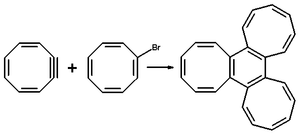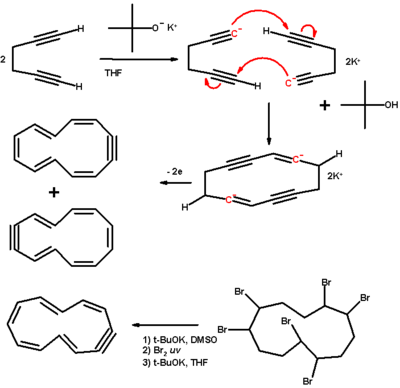
Annulyne
Encyclopedia
Annulynes or 1,2-didehydroannulenes are conjugated
monocyclic hydrocarbon
s with alternating alkene
bonds in addition to at least one alkyne
bond.
 They are related to annulene
They are related to annulene
s who have just alternating double bonds. The smallest member of this class is [4]annulyne and never observed because the molecule carries too much angle strain
. The next member is [6]annulyne or benzyne which is a reactive intermediate
well known in organic chemistry
. [8]annulyne is known to exist but quickly dimerizes or trimerizes. The compound has been trapped as its radical anion
and observed by EPR spectroscopy. [10]annulyne, like [4]annulyne only exists in theory.
 [12]annulyne has been observed in 2005 by Stevenson et al. in solution by NMR spectroscopy
[12]annulyne has been observed in 2005 by Stevenson et al. in solution by NMR spectroscopy
at room temperature
. Reaction of 1,5-hexadiyne and potassium tert-butoxide
was reported to yield two isomers 5,9-di-trans-[12]-annulyne and 3,11-di-trans-[12]annulyne in a 1:1 ratio. The proposed reaction sequence involved an unspecified electron transfer reaction. A third single isomer 3,9-Di-trans-[12]annulyne could be obtained in three steps from hexabromocyclododecane.
Unlike other annulynes, the [12]annulyne isomers were found to be very stable and did not self-condense. These annulynes reacted with potassium metal to form radical anion
s and dianions. The NMR chemical shift
s of two internal protons of the dianion were negative and attributed to an aromatic diamagnetic ring current. The external proton next to the alkyne
group had a chemical shift of nearly 14 and attributed to the positive charge of the potassium cation coordinated to it.
 Two new [12]annulyne isomers were reported in 2008 by the same group
Two new [12]annulyne isomers were reported in 2008 by the same group
The Stevenson findings were challenged by Christl and Hopf in 2009. They were unable to conceive a plausible mechanism and argued that based on the available spectroscopic data the products formed were in fact two linear 1,3-hexadien-5-yne isomers and not macrocycles. Computational analysis of this compound suggests valence isomerization to biphenyl
is very exothermic but also with a high kinetic barrier.
[14]annulyne was reported in 1962 by Jackman et al.
whose research group reported bisdehydro[12]annulene in 1962 and 1,5,9-tridehydro[12]annulene in 1966 .A dehydrobenzo[14]annulene was reported in 2001 by Boydston and Haley
Conjugated system
In chemistry, a conjugated system is a system of connected p-orbitals with delocalized electrons in compounds with alternating single and multiple bonds, which in general may lower the overall energy of the molecule and increase stability. Lone pairs, radicals or carbenium ions may be part of the...
monocyclic hydrocarbon
Hydrocarbon
In organic chemistry, a hydrocarbon is an organic compound consisting entirely of hydrogen and carbon. Hydrocarbons from which one hydrogen atom has been removed are functional groups, called hydrocarbyls....
s with alternating alkene
Alkene
In organic chemistry, an alkene, olefin, or olefine is an unsaturated chemical compound containing at least one carbon-to-carbon double bond...
bonds in addition to at least one alkyne
Alkyne
Alkynes are hydrocarbons that have a triple bond between two carbon atoms, with the formula CnH2n-2. Alkynes are traditionally known as acetylenes, although the name acetylene also refers specifically to C2H2, known formally as ethyne using IUPAC nomenclature...
bond.

Annulene
Annulenes are completely conjugated monocyclic hydrocarbons. They have the general formula CnHn or CnHn+1...
s who have just alternating double bonds. The smallest member of this class is [4]annulyne and never observed because the molecule carries too much angle strain
Angle strain
Angle strain, also called Baeyer strain in cyclic molecules, is the resistance associated with bond angle compression or bond angle expansion. It occurs when bond angles deviate from the ideal bond angles to achieve maximum bond strength in a specific chemical conformation...
. The next member is [6]annulyne or benzyne which is a reactive intermediate
Reactive intermediate
In chemistry a reactive intermediate is a short-lived, high energy, highly reactive molecule. When generated in a chemical reaction it will quickly convert into a more stable molecule. Only in exceptional cases can these compounds be isolated and stored, e.g. low temperatures, matrix isolation...
well known in organic chemistry
Organic chemistry
Organic chemistry is a subdiscipline within chemistry involving the scientific study of the structure, properties, composition, reactions, and preparation of carbon-based compounds, hydrocarbons, and their derivatives...
. [8]annulyne is known to exist but quickly dimerizes or trimerizes. The compound has been trapped as its radical anion
Radical ion
A radical ion is a free radical species that carries a charge. Radical ions are encountered in organic chemistry as reactive intermediates and in mass spectrometry as gas phase ions...
and observed by EPR spectroscopy. [10]annulyne, like [4]annulyne only exists in theory.

NMR spectroscopy
Nuclear magnetic resonance spectroscopy, most commonly known as NMR spectroscopy, is a research technique that exploits the magnetic properties of certain atomic nuclei to determine physical and chemical properties of atoms or the molecules in which they are contained...
at room temperature
Room temperature
-Comfort levels:The American Society of Heating, Refrigerating and Air-Conditioning Engineers has listings for suggested temperatures and air flow rates in different types of buildings and different environmental circumstances. For example, a single office in a building has an occupancy ratio per...
. Reaction of 1,5-hexadiyne and potassium tert-butoxide
Potassium tert-butoxide
Potassium tert-butoxide is the chemical compound with the formula 3COK. This colourless solid is a strong base useful in organic synthesis. It exists as a tetrameric cubane-like cluster...
was reported to yield two isomers 5,9-di-trans-[12]-annulyne and 3,11-di-trans-[12]annulyne in a 1:1 ratio. The proposed reaction sequence involved an unspecified electron transfer reaction. A third single isomer 3,9-Di-trans-[12]annulyne could be obtained in three steps from hexabromocyclododecane.
Unlike other annulynes, the [12]annulyne isomers were found to be very stable and did not self-condense. These annulynes reacted with potassium metal to form radical anion
Radical ion
A radical ion is a free radical species that carries a charge. Radical ions are encountered in organic chemistry as reactive intermediates and in mass spectrometry as gas phase ions...
s and dianions. The NMR chemical shift
Chemical shift
In nuclear magnetic resonance spectroscopy, the chemical shift is the resonant frequency of a nucleus relative to a standard. Often the position and number of chemical shifts are diagnostic of the structure of a molecule...
s of two internal protons of the dianion were negative and attributed to an aromatic diamagnetic ring current. The external proton next to the alkyne
Alkyne
Alkynes are hydrocarbons that have a triple bond between two carbon atoms, with the formula CnH2n-2. Alkynes are traditionally known as acetylenes, although the name acetylene also refers specifically to C2H2, known formally as ethyne using IUPAC nomenclature...
group had a chemical shift of nearly 14 and attributed to the positive charge of the potassium cation coordinated to it.

The Stevenson findings were challenged by Christl and Hopf in 2009. They were unable to conceive a plausible mechanism and argued that based on the available spectroscopic data the products formed were in fact two linear 1,3-hexadien-5-yne isomers and not macrocycles. Computational analysis of this compound suggests valence isomerization to biphenyl
Biphenyl
Biphenyl is an organic compound that forms colorless crystals. It has a distinctively pleasant smell. Biphenyl is an aromatic hydrocarbon with a molecular formula 2...
is very exothermic but also with a high kinetic barrier.
[14]annulyne was reported in 1962 by Jackman et al.
Other annulynes
Dehydroannulenes with more than one alkyne group were pioneered by Franz SondheimerFranz Sondheimer
-Early life:Sondheimer was born in Stuttgart, Germany in 1926 and, following the rise of the Nazis, fled to the United Kingdom in 1937.-Education:He was a pupil at Highgate School and subsequently studied chemistry, receiving his degree from Imperial College London.-Career:From 1949 to 1952,...
whose research group reported bisdehydro[12]annulene in 1962 and 1,5,9-tridehydro[12]annulene in 1966 .A dehydrobenzo[14]annulene was reported in 2001 by Boydston and Haley

